Manual Handling Techniques That Prevent Workplace Injuries
Author: MHA Products Date Posted:7 November 2014
Manual handling is responsible for causing over a third of all workplace related injuries. These injuries include musculoskeletal disorders and strain injuries due to repetitive activities. Musculoskeletal disorders consist of injury to legs, arms and joints. Manual handling covers a number of workplace activities such as the following:
- Carrying
- Pushing
- Lowering
- Lifting
If any of these activities are not carried out properly there is a good risk of injury. Educating people about proper handling and storage of products is important for ensuring safety in the workplace.
Before performing the lift or carry, you must remove any obstructions or debris from your path. For a long lift, plan a midpoint where you can rest and change your grip. The load should be kept close to the waist, as it is a good practice to keep the load close to the body for the maximum possible duration during a lift. Adopt a stable position during a lift and ensure that the heaviest part of the load is closest to your body.
Plan the Lift
Ensure that a proper strategy is in place before the lift. Check if you can handle the weight, if help is needed, remove any obstructions in the path.
Take up a Stable Position
Your feet should be apart with one of the legs slightly out to take up excess load and maintain balance. You should be prepared to move your feet during the loading or handling activity to maintain stability. Ensure that you are wearing proper footwear and clothing during the lift.
Get a Good Grip
As far as possible, hold the weight in such a way that it is as close to the body as possible. This lends extra support without relying solely on the hands.
Keep the weight close to the waist
Keep the heaviest end of the load close to the waist during the lift. If you cannot approach the load directly at close proximity, then attempt to slide it across towards your body before going ahead with the lift.
Avoid twisting or leaning while carrying the load
Your shoulders should be kept level and facing the same direction as the hips at all times. It is better to move and change directions with your feet rather than twisting your back or waist.
Keep your head up during the handling activity
Once the lifting has been done, try to keep your head straight. Once it has been secured there should be no need to look down on the load you are carrying.
Ensure that the Lift is smooth
The load should not be snatched off the platform as this sudden movement can make the handling process difficult and increase the chances of injury.
Lift loads that you can handle
There is a difference between what you can lift and what you can safely lift. Work within your limits and have a good idea about how much you can lift without causing undue strain and subsequent injury. Seek help or advice to help you understand how much weight you can handle.
Adjustments should be done after putting down the load
If any adjustments are to be done to the positioning of the load or the body, put down the load. Then proceed to make necessary changes. Only after this should you continue with the handling process. Any movements or jerks during the process can lead to injury.
Also there may be potential risk factors on the premises that increase the risk of workplace injury:
- Working in the same posture for a great period of time can increase the chances of an injury.
- The overall layout of the workplace can also contribute to injuries. A poorly designed or overly cramped environment can force workers to assume uncomfortable postures while doing lifting or handling activities and hence lead to injury.
- The weight of individual loads should be regulated so that it is relatively easy to handle for workers.
- The location of an object to be lifted can be a contributor to injury if the worker has to assume awkward positions to lift it. Heavy objects should not be placed above shoulder height or below knee level.
- Loads that are awkwardly shaped, difficult to grip or slippery can contribute to workplace injury.
- Lifting loads with living beings can be tricky, due to their unpredictable movement. This can increase the chances of injury.
Since the back is the part of the body that is strained the most during manual handling or other workplace related activities we can take some specific precautions to protect our back:
- Before starting any manual work do some gentle stretching
- Try to lift with upper body muscles
- Keep the load close to the body
- Never attempt to lift loads you know for sure are too heavy for you
Pushing a heavy load using your body weight is much less strenuous than pulling a load. If there are mechanical load tools available always prefer using them when handling heavy loads. Plan the lift and handling process by organizing the work area. Take breaks whenever possible to provide time for the muscles to relax. It is a good idea to exercise regularly to strengthen muscles and get rid of any excess body fat. This will help with your handling activities giving you extra strength and manoeuvrability.
So basically to reduce workplace related injuries we have to take care of the above mentioned points. Serious injuries can end your career and this can be detrimental for the employer as well. Safety regulations must be enforced to ensure a healthy injury free environment. A safety coordinator must be employed who can conduct regular internal audits to determine areas where there is risk of injury.
Workshops must be conducted to instruct the workers on proper lifting procedures and techniques. As much as possible employees must be rotated among different tasks so that strain related injuries don’t occur. These manifest when the one performs the same task for a prolonged period of time.
It should be ensured that employees are not lifting weights which are too heavy for them to handle. Also the manner of storage of the load should be conducive to the lifting and handling process. Hence manual handling and storage of products are important topics that need to be given high priority.




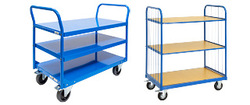

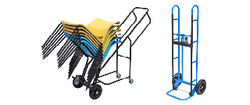


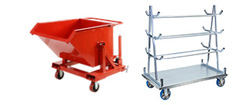
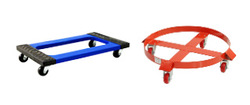
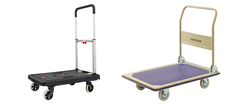
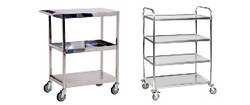

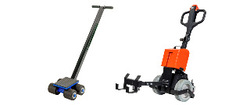
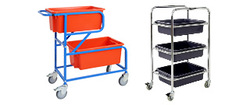
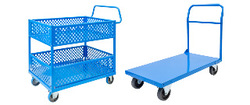
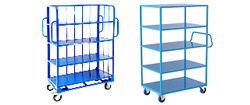
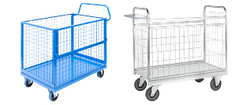
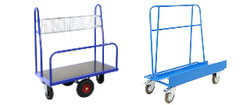
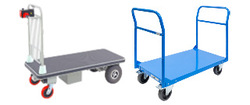
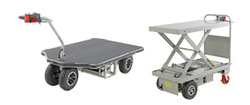

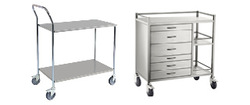
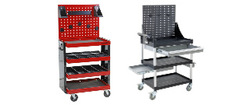
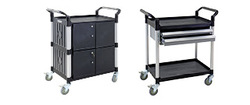
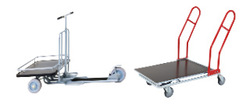
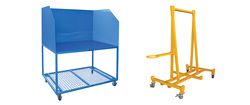



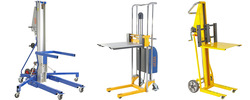



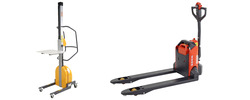
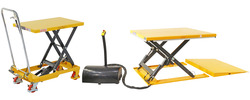
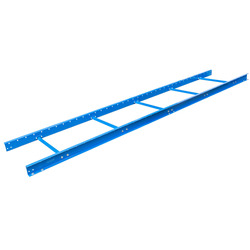
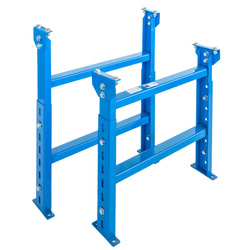

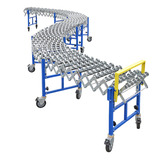




















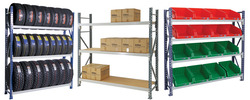
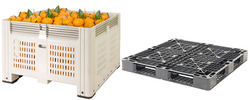
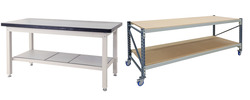
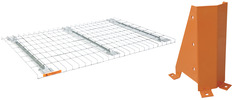
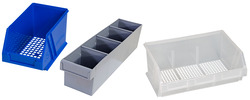



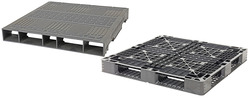

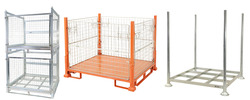

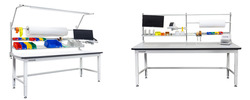

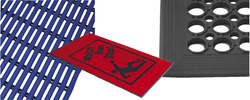




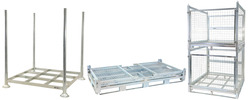
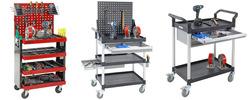
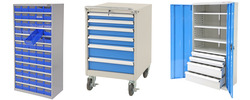

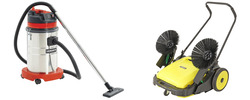











 Trolleys / Hand Trucks
Trolleys / Hand Trucks 2 Tier Trolleys
2 Tier Trolleys 3 Tier Trolleys
3 Tier Trolleys Aluminium Trolleys
Aluminium Trolleys Appliance & Hand Trucks
Appliance & Hand Trucks Cage Trolleys
Cage Trolleys Cleaning Carts & Trolleys
Cleaning Carts & Trolleys Construction Trolleys
Construction Trolleys Dollies
Dollies Foldable Trolleys
Foldable Trolleys Hospital Trolleys
Hospital Trolleys Laundry/Linen Trolleys
Laundry/Linen Trolleys Load Skates & Tow Tugs
Load Skates & Tow Tugs Mail / Office Trolleys
Mail / Office Trolleys Multi Purpose Trolleys
Multi Purpose Trolleys Multi-Tier Shelf Trolleys
Multi-Tier Shelf Trolleys Order Picking Trolleys
Order Picking Trolleys Panel Cart Trolleys
Panel Cart Trolleys Platform Trolleys
Platform Trolleys Powered Trolleys
Powered Trolleys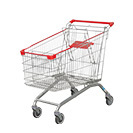 Shopping Trolleys
Shopping Trolleys Stainless Steel Trolleys
Stainless Steel Trolleys Tool Trolleys
Tool Trolleys Utility Carts
Utility Carts Warehouse Trolleys
Warehouse Trolleys Custom Trolleys
Custom Trolleys Lifting Equipment
Lifting Equipment Forklift Attachments
Forklift Attachments Jib Attachments
Jib Attachments Lifting Hoists & Pallet Hooks
Lifting Hoists & Pallet Hooks Manual Stackers & Lifters
Manual Stackers & Lifters Pallet Jacks
Pallet Jacks Pallet Lifters
Pallet Lifters Pallet Rotators & Dispenser
Pallet Rotators & Dispenser Powered Pallet Trucks & Electric Lifters
Powered Pallet Trucks & Electric Lifters Scissor Lift Trolleys and Tables
Scissor Lift Trolleys and Tables Conveyor Equipment
Conveyor Equipment Conveyor Frames
Conveyor Frames Conveyor Stands
Conveyor Stands Roller Conveyors
Roller Conveyors Skate Wheel Conveyors
Skate Wheel Conveyors Access Equipment
Access Equipment Container & Yard Ramps
Container & Yard Ramps Step Stools & Ladders
Step Stools & Ladders Work Platforms & Crane Cages
Work Platforms & Crane Cages Drum Handling
Drum Handling Drum Storage & Bunding
Drum Storage & Bunding Drum Trolleys & Lifters
Drum Trolleys & Lifters Forklift Drum Handling
Forklift Drum Handling Containment & Spillage
Containment & Spillage Aerosol Cans Storage Cages
Aerosol Cans Storage Cages Bunded Pallets & Storage
Bunded Pallets & Storage Corrosive Goods Storage Cabinets
Corrosive Goods Storage Cabinets Flammable Liquid Cabinets
Flammable Liquid Cabinets Forklift Gas Storage Cages
Forklift Gas Storage Cages Gas Cylinder Storage
Gas Cylinder Storage Site Storage
Site Storage Spill Kits
Spill Kits Stillage Cages
Stillage Cages Waste Handling
Waste Handling Bin Lifters & Tippers
Bin Lifters & Tippers Plastic Waste Bins and Carts
Plastic Waste Bins and Carts Steel Waste and Tipping Bins
Steel Waste and Tipping Bins Storage Equipment
Storage Equipment 750 Series Cage Configurations
750 Series Cage Configurations Heavy Duty Cabinets & Benches
Heavy Duty Cabinets & Benches Heavy Duty Shelving
Heavy Duty Shelving Mega Bins & Pallets
Mega Bins & Pallets Packing Benches
Packing Benches Pallet Racking Accessories
Pallet Racking Accessories Parts Trays & Stor-Pak Bins
Parts Trays & Stor-Pak Bins Pegboard & Louvre Panels
Pegboard & Louvre Panels Plastic Bins
Plastic Bins Plastic Handling Solutions Bins
Plastic Handling Solutions Bins Plastic Pallets
Plastic Pallets Stack & Nest Bins
Stack & Nest Bins Storage Cages
Storage Cages Workplace Equipment
Workplace Equipment Workbenches
Workbenches Modular Workbenches
Modular Workbenches Electric Height-Adjustable Workbenches
Electric Height-Adjustable Workbenches Floor Matting
Floor Matting Industrial Weighing Scales
Industrial Weighing Scales Pallet Wrapping & Packaging Machinery
Pallet Wrapping & Packaging Machinery Ramps
Ramps Stationery Cupboards
Stationery Cupboards Storage and Stillage Cages
Storage and Stillage Cages Tool Trolleys
Tool Trolleys Tooling Cabinets
Tooling Cabinets Wheelie Bins
Wheelie Bins Workshop Equipment
Workshop Equipment Safety Equipment
Safety Equipment Gloves and PPE
Gloves and PPE Pallet Rack Post Protectors
Pallet Rack Post Protectors Safety Barriers & Bollards
Safety Barriers & Bollards Safety Knives & Cutters
Safety Knives & Cutters Signs and Traffic Supplies
Signs and Traffic Supplies Tool & First Aid Boxes
Tool & First Aid Boxes Construction Equipment
Construction Equipment Concrete Equipment
Concrete Equipment General Site Equipment
General Site Equipment Lifting Equipment
Lifting Equipment Site Storage
Site Storage Waste
Waste 










